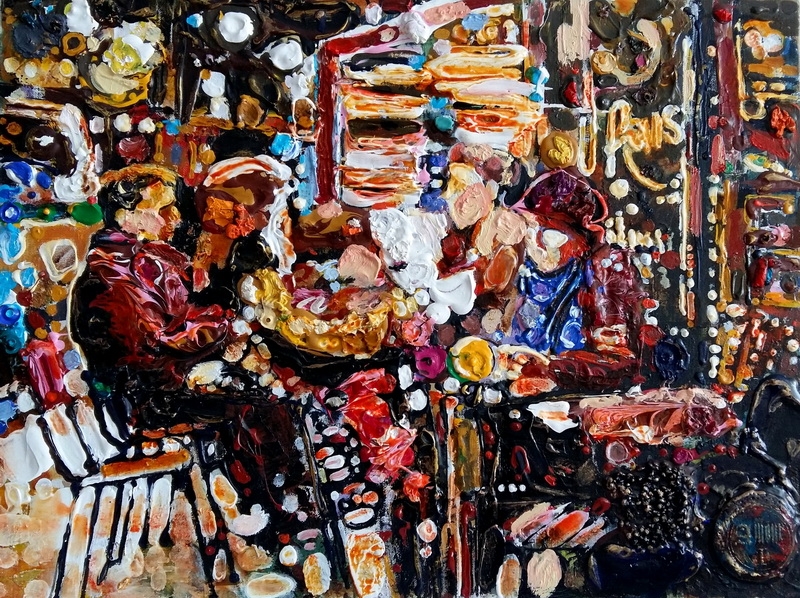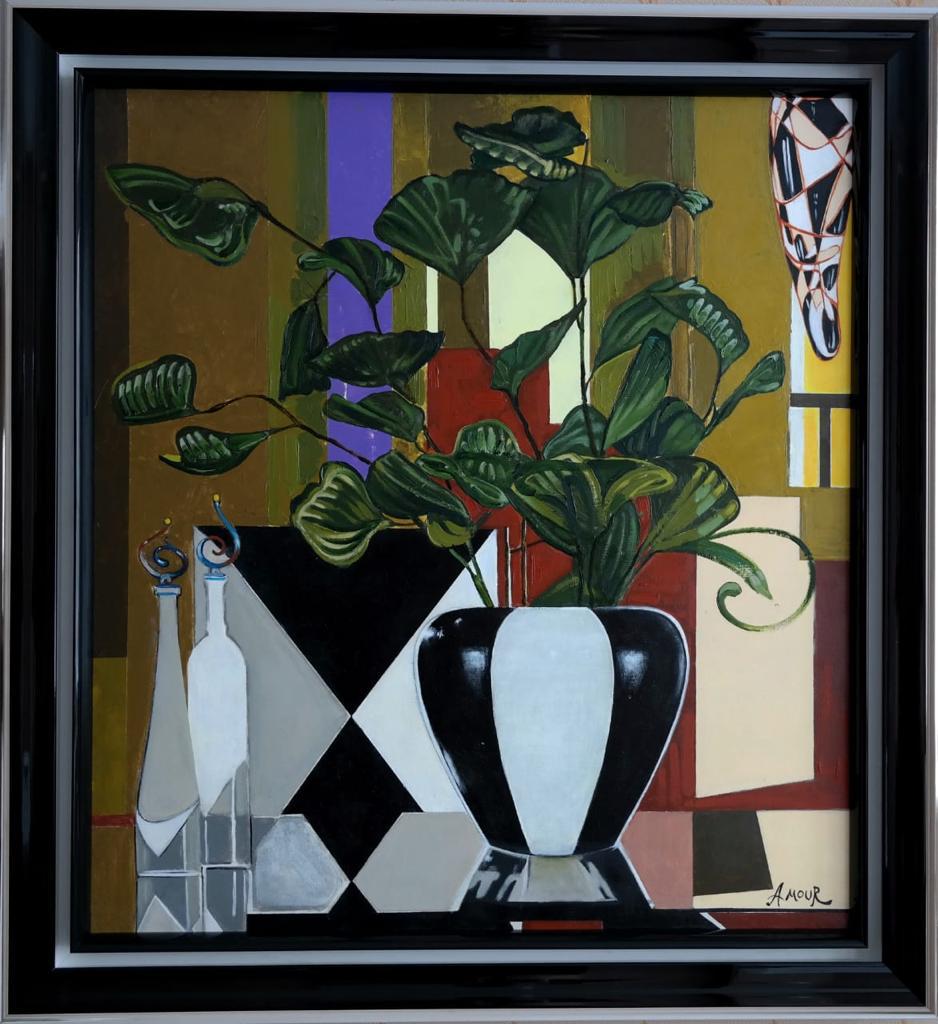Artak Muradyan, known by his artistic pseudonym Amour, is an artist whose work transcends mere aesthetics to explore the profound depths of human experience.
With a career marked by significant collections and an ever-evolving style, Amour has firmly established himself as a master in the realm of fine arts. His paintings exude a sense of mystery, originality, and nobility, offering a kaleidoscopic reflection of reality through a contemplative lens.
Early Beginnings and Education
Like many talented individuals, Amour’s artistic journey began at a young age. When asked about his early works and what he drew as a child, he responded, “Mainly portraits and fairy-tale characters.” His biography reveals that he created his first plaster sculpture at the age of seven, indicating an early ability to perceive and recreate the world in three dimensions.
Upon graduating from high school in Yerevan, he pursued his passion for sculpture at the Yerevan State Art College named after P. Terlemezian. Graduating with honors in 1990, he continued his education at the Yerevan State Institute of Theatre and Cinematography, majoring in sculptures while also practicing painting. In 1993, Amour decided to further his studies at the Repin Institute of Painting, Sculpture, and Architecture of the Russian Academy of Arts in Saint Petersburg.
Professional Development and Exhibitions
By 2007, having honed his skills and developed a unique style, Amour relocated to Moscow, where he continued his exhibition activities that began in Yerevan in 1985.
His work has been featured in over 300 art projects, both personal and collective, showcasing his pieces alongside those of distinguished contemporary artists.
The Early Period: 1990-1996
Amour’s early works, such as the “Old Jugs,” embody a paradox of simplicity and complexity. The splash of pale colors depicting dried grasses in a clay jug harmonizes with a similar splash over a smaller jug holding brushes.
This “oneness of color” would be appreciated by artists like Valentin Podpomogov, a philosopher and realist with whom Amour crossed paths in Yerevan. Despite such influences, Amour carved his own distinct path in art, often engaging with historical and artistic passions.
When asked which artists he values most, he answered, “I have admired many, from Michelangelo to Picasso. It’s not so much the artists themselves but certain paintings and fragments that bring me ecstasy. Like the heel of the Prodigal Son by Rembrandt, where the entire technique and virtuosity of world painting are concentrated.”
Notable Works and Influences
“Northern Bride”
One of his most psychologically profound works from the 1995-97 period is “Northern Bride.” This portrait of a woman in a white wedding dress with a theatrical, mesh veil is striking not for its adornments but for the proud, cool beauty of the woman. Her keen, large eyes and the softness of her hands contrast with an almost eagle-like, Eastern intensity in her narrow face.
“Portrait of an Actress”
Another significant work from his early period is the “Portrait of an Actress,” portraying a more surface-level emotionality. The rich attire, complete with hat and feather boa, does not create a distance between the viewer and the subject. Instead, the painting affirms her own emotions, hinted at by a symbolic birdcage in the background.
Landscapes and Still Lifes
Amour’s landscapes from this period, such as “Steps to the Sea,” capture the warmth and character of southern climates. The painting exudes the heat reflected from a descent to the sea, evoking places like Greece, Italy, Spain, and Crimea. His still life above showcases his geometric emphasis of white and black paint and the elegance of the composition.
Mid-Career Evolution: The Venetian Cycle
Amour’s extensive travels greatly influenced his artistic evolution. Italy and Spain left indelible marks on his work. “Italy. A special world. Venice and its aesthetics still captivate me to this day,” he shared. The Venetian Carnival, in particular, inspired many pieces, such as “Night Serenade for Mannequins,” characterized by surreal clarity and symbolic clock faces.
The white masks of characters from the Commedia dell’Arte and the rich golden background create a distinctly Venetian atmosphere.
Later Works and Techniques
Amour’s later works diverge significantly in both character and technique. He began to experiment with a thickly impastoed acrylic style, where melted, relief forms act as a boundary between reality and the abstraction.
His pieces like “Basilica San Marco, Misty Mood” and “Santa Maria della Salute Cathedral” from 2019 exhibit a cohesive and majestic quality despite the brushstroke’s conventionality.
“On the Shore. Italian Motifs” and “Old Europe”
These works exemplify Amour’s mastery in his thick impasto style, creating a symphonic variation of form and aesthetics. The expressionistic “Notre Dame” echoes this musical dynamism, further emphasizing his innovative approach to architecture in art.
Unique Techniques
In “Moscow Cried in the Rain,” Amour achieves a novel effect by depicting the view as if through a car’s windshield, with rain streaks and blurred drops adding a layer of modernity and uniqueness to the artwork.
Exhibitions and Recognition
Amour’s numerous exhibitions worldwide have garnered acclaim from art critics and connoisseurs alike. With over 350 international exhibitions, his work has captivated audiences globally.
His exhibition at the Ethnographic Museum in Saint Petersburg stands out, where he received high praise from teachers and colleagues from the Repin Academy and art critics from the Russian Museum.
Philosophy on Talent
When asked about his understanding of the term “talent,” Amour responded thoughtfully: “I am wary of words like ‘talent’ or ‘genius.’ There are untalented people, capable people, gifted people, talented people, great people, and geniuses.
Geniuses like Michelangelo, Leonardo, Rubens, Mozart, Paganini, Pushkin, and Shakespeare are recognized planetary figures. But talent, in my opinion, is when a child is kissed by God at birth.”
Discover Amour’s Artworks at Bingyol’s Art Gallery, Dubai
You can find Amour’s exceptional artworks exclusively in the UAE at Bingyol’s Art Gallery. Located at the West Crescent, Palm Jumeirah at the Kempinski Hotel and Residences in Dubai, the gallery offers a unique opportunity to experience the profound beauty and depth of Amour’s creations.
Whether you are an art connoisseur or a casual enthusiast, visiting Bingyol’s Art Gallery will allow you to immerse yourself in the captivating world of Artak Muradyan. To explore his works further, visit Bingyol’s Art Gallery!











